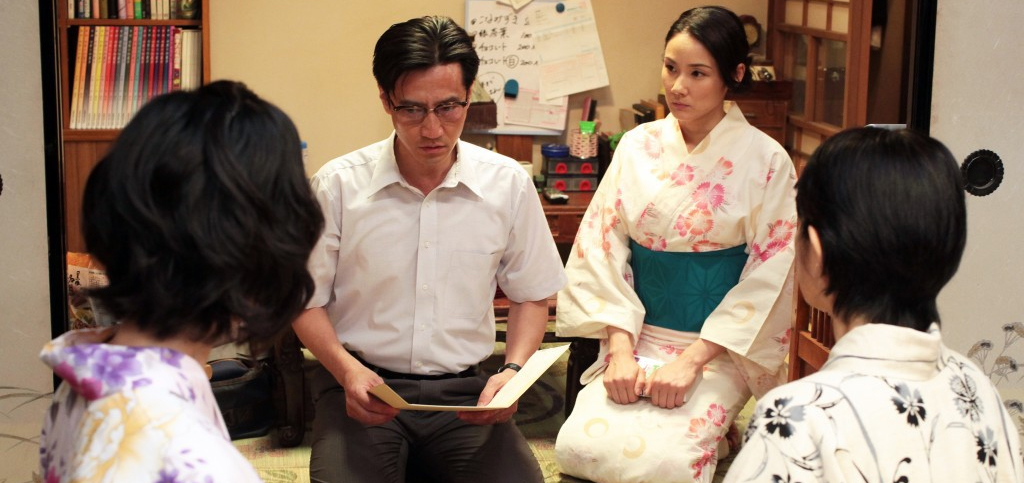
Kiyoshi Sasabe’s dramatic comedy Three Sisters, surprisingly enough, calls to mind a merger of the sensibilities found in Downton Abbey and the work of Jane Austen. It’s an eerie concoction of expected narrative tropes, garnished with a hint of acerbic wit, topped with spurts of comic extravagance, much like the experimental batches of confectionery made by the Toraya family that tickle the taste buds of everyone in the film.
Shinpei (Seishiro Nishida) is the head of a dysfunctional family. He runs a confectionery shop in the small town of Kagoshima with his divorced wife (Yoshie Ichige) and two of his three daughters. The eldest daughter, Shizue (Yo Yoshida), has been staying with the family, helping with the business after going through her own marital troubles. The youngest daughter, Sakae (Eri Tokunaga), has just about hit that age where she is going through her ‘rebellious’ phase. In this hotchpotch of family relations arrives Namie (Kazue Fukiishi), the middle daughter, after filing for divorce from her husband in Tokyo. Namie’s husband follows her back home, not ready to give up on her just yet. How the family navigates through their respective relationships forms the crux of the narrative.
There isn’t much in terms of narrative progression to hold the viewer’s attention. The dysfunctional family trope has been used numerous times in dramatic comedies. What the film lacks in plot and narrative novelty, it somewhat makes up for it through witty dialogues. I’m unsure to what extent the English subtitles were transliterations as opposed to translations, because the meaning is lost at times, but for the majority of the film, the humour carries over across the language barrier remarkably well. This is laudable given the fact that the film relies quite heavily on wordplay and linguistic humour.
The female characters in Three Sisters are the ones that dictate the power dynamic throughout the film. This was quite refreshing, and perhaps deliberate from Sasabe, after making it obvious in several instances that Japanese society is patriarchal in nature. Sasabe cleverly plays up this inversion – where from a social perspective, the male identifying characters make it quite clear that a woman’s agency is intrinsically linked to a man’s presence. However, the male characters often find themselves in situations where they surrender their power and instead are forced to give the female characters their agency to make their own choices, free from social pressure or expectation.
There are several examples of this, which invariably makes this film more attuned to western sensibilities. Shinpei’s male friends – ‘the wolf pack’ – openly objectify his three daughters because they are single and ‘in need of a man’. Furthermore, Shizue, the eldest daughter, is seen as damaged goods as she is divorced and has been living at home for some time, which in turn, reflects badly on Shinpei’s social reputation. However, Sasabe is quick to inverse the power dynamic as well. Sakae, the youngest daughter, is able to socially shame a man who follows her by yelling “Stalker!” loudly in a public area. Moreover, even though Namie’s husband follows her home to talk her out of their impending divorce, Shinpei leaves the decision entirely up to his daughter, knowing that he has himself been through a divorce and has no pearls of wisdom to give. The bumbling, apologetic character of Namie’s husband drives this idea of social inversion home. Even though he is a male character and, legally, still Namie’s husband (a fact that he reminds everyone of any chance he gets), he is never in control of the power dynamic with any character in the film. He is overly apologetic towards Namie and her parents because he wants to win her over. He is uncomfortable in the presence of Shizue, the eldest daughter, because it’s a harsh social reminder of the status of divorced women and invariably, he would feel responsible if the divorce with Namie were to be finalised for putting her in this socially contemptuous position.
The highlights of the film are undoubtedly the snippets of conversation that the titular three sisters have among themselves, which have a surprising similarity in tone to the exchanges between Austen’s Bennet sisters. They prove to be the vessels for social commentary of Japanese society in a manner that sets the film apart from a clichéd dysfunctional family narrative. Discussions regarding status of women in Japan, meaning and necessity of marriage, social attitudes of married verses single women, and constant objectification of women lift the narrative beyond expected lines.
Having said that, there are other thematic elements that don’t quite work. Chief among them is the subplot of capitalism being responsible for eroding the livelihood of small businesses and destroying smaller communities. While Shinpei and his wolf pack often quip about supermarkets and ‘city life’ destroying the ecosystem of smaller towns, Mizutani’s screenplay doesn’t let this thread develop any further than disgruntled non sequiturs.
Sasabe’s use of inversion to provide female characters agency lifts The Three Sisters from a clichéd dysfunctional family narrative to a refreshing social commentary about women in Japanese society. The narrative still plods along on expected lines, but the film manages to engage thanks to the subject’s treatment.
